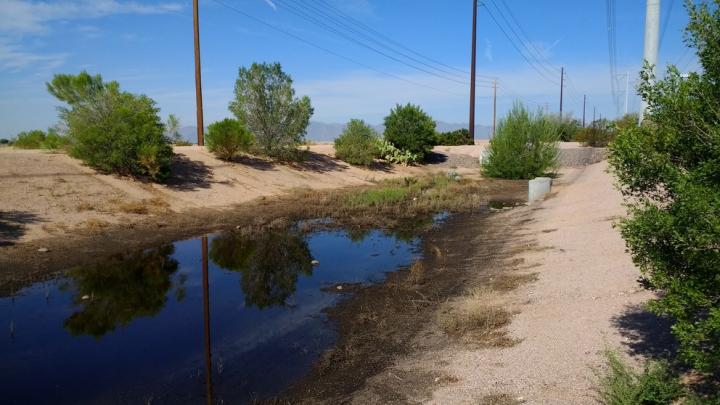
Credit: Lauren McPhillips
Urban development in the eastern United States results in an increase in flash flooding in nearby streams, but in the arid West, urbanization has just the opposite effect, according to a Penn State researcher, who suggests there may be lessons to be learned from the sharp contrast.
Lauren McPhillips, assistant professor of civil and environmental engineering, who led a study of how urban development affects stream flows in the Phoenix, Arizona, metropolitan area, believes the research may yield clues for better stormwater management everywhere.
“We found that ‘flashiness’ — a measure of the rise and fall rates of water flow in streams — actually decreased with the extent of imperviousness in arid, urban, Southwest watersheds,” said McPhillips, who has appointments in the colleges of Agricultural Sciences and Engineering. “That is the opposite pattern to that observed in previous studies in wetter regions such as the East.”
Researchers analyzed 14 years of flow records from U.S. Geological Survey stream gauges and similar data from the Flood Control District of Maricopa County to determine how hydrologic characteristics varied with urban development. The study looked at 19 watersheds that drained areas ranging in size from less than a square mile to 175 square miles.
Similar to wetter systems, researchers observed more high-flow events in the urban desert streams compared to nonurban desert streams, she explained. However, this was only at the lower flood threshold — there was no increase in larger floods with urban development.
“Overall, the urban stream syndrome manifests differently in this arid system — urbanization increases water retention and leads to less variable flows in stream ecosystems,” said McPhillips.
McPhillips — who started the research as a postdoctoral scholar at Arizona State University before joining the Penn State faculty to focus explicitly on urban hydrology and green infrastructure — hopes to apply some of what she learned in the West to her new role. In the arid West, she noted, water quantity is more of an issue, and flash flooding is a really big concern, along with water availability in aquifers and water scarcity.
In the East — especially in the Chesapeake Bay drainage — stormwater management is equally linked to water-quality worries. Reducing pollution from urban runoff is one of the strategies for cleaning up the bay.
“Arizona was an interesting case study to try to understand more about urbanization and the role of intentional engineered stormwater management structures because urban areas there have developed a lot more recently, and they still are growing rapidly,” McPhillips said. “The Phoenix area has had pretty progressive stormwater management policies for a while, and we looked at some watersheds where there was an extremely high implementation of stormwater-control features. So we could start to detect whether or not they are influencing stream-flow patterns.”
The research findings, recently published in Water Resources Research, were unique because they documented for the first time the reduced flashiness of arid urban streams in the West and showed what a big role so-called “dry weather flows” are playing in overall streamflow patterns, fed by air conditioner condensate, turfgrass irrigation, wastewater treatment plant effluent and other more obscure sources.
“It was kind of weird to see water coming into the stream and creating a minimum flow on a day when there normally would not be any flow at all,” she said. “It’s something that is different from anything we would see here, because in the East there are constant groundwater flows.”
The opportunity to detect the influence of stormwater management efforts in the West stands out as the biggest difference for McPhillips. In the East, cities are much older, and municipalities are retrofitting stormwater management features into existing storm sewer infrastructure. That makes it much more difficult to judge the success or failure of engineering features since there may not be enough of them to detect their impact downstream.
“Phoenix, in particular, is a very new city, and municipal leaders were pretty forward-thinking in that they built flood control facilities as the urban area grew,” she said. “There are whole watersheds there that have pretty substantial quantities of water management features. It was kind of exciting to find cases in the West where we could see clearly the result of stormwater management engineering.”
###
Also involved in the research were Stevan Earl and Julie Ann Wrigley, Global Institute of Sustainability; Nancy Grimm, School of Life Sciences, Arizona State University; and Rebecca Hale, Department of Biological Sciences, Idaho State University.
The National Science Foundation via the Central Arizona Phoenix Long-Term Ecological Research Program and the Urban Resilience to Extremes Sustainability Research Network supported this research.
Media Contact
A’ndrea Elyse Messer
[email protected]
814-865-5689
Related Journal Article
http://dx.





